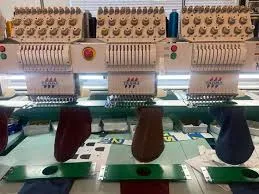Aug . 31, 2024 04:56 Back to list
embroidery machine
The Evolution of Embroidery Machines
Embroidery has long been a cherished art form, weaving intricate designs into fabric, adding elegance and personal touch to clothing and accessories. As technology has progressed, so too has the method of embroidery. The rise of embroidery machines marks a significant milestone in this artistic tradition, revolutionizing the way designs are created and produced.
Historically, embroidery was a labor-intensive process, requiring hours of skilled handwork. Artisans spent years mastering their craft, stitching designs that often told stories or conveyed cultural significance. While this traditional approach holds immense value and beauty, it can be time-consuming and limited in scope. Enter the embroidery machine—a technological advancement that has transformed the craft for both professionals and hobbyists alike.
The first embroidery machines emerged in the early 19th century, profoundly changing the landscape of textile production. Initially designed for mass production, they allowed manufacturers to create complex patterns quickly and consistently. These early machines, however, were rudimentary, often requiring significant manual intervention and offering limited design capabilities.
The late 20th century saw significant improvements in embroidery technology. Computerized embroidery machines began to dominate the market, equipped with software that could digitize designs and automate the embroidery process. This innovation not only increased efficiency but also expanded the creative possibilities for designers. Now, intricate patterns, logos, and personalized designs could be executed with precision and speed that were unimaginable with hand crafting.
embroidery machine

Today’s embroidery machines are equipped with advanced features such as multiple needles, automatic thread cutting, and a variety of stitching techniques. They connect to computers via USB, allowing users to import designs easily. This connectivity opens up endless possibilities for custom embroidery, making it popular among small businesses, fashion designers, and craft enthusiasts.
Moreover, the accessibility of embroidery machines has democratized the art form, enabling aspiring artists to explore their creativity without the steep learning curve once associated with traditional embroidery. Online tutorials and user-friendly software provide invaluable resources, empowering individuals to bring their visions to life effortlessly.
Additionally, the rise of e-commerce has created a demand for unique and personalized products, further fueling the popularity of embroidery. Businesses can now quickly produce customized items, from monogrammed towels to branded apparel, catering to the growing consumer preference for individuality.
In conclusion, embroidery machines have not only transformed the production of embroidered items but have also revitalized an ancient craft, making it more accessible and exciting than ever. As technology continues to advance, it will be fascinating to see how embroidery evolves, blending tradition with innovation, and inspiring new generations of creators in the world of textiles.
-
Affordable 15-Needle Embroidery Machine with GPT-4 Turbo
NewsAug.02,2025
-
Affordable Commercial Embroidery Machines for Sale
NewsAug.01,2025
-
Top AI Embroidery Machine Manufacturers | GPT-4 Turbo Tech
NewsJul.31,2025
-
Affordable Computer Embroidery Machines | Best Prices
NewsJul.31,2025
-
Cheap T Shirt Printing Embroidery Machine with Multi Needle Efficiency
NewsJul.30,2025
-
High-Quality T Shirt Embroidery Machine – Multi & 12/15 Needle Options
NewsJul.30,2025

Copyright © 2025 Xingtai Pufa Trading Co., Ltd All Rights Reserved. Sitemap | Privacy Policy
